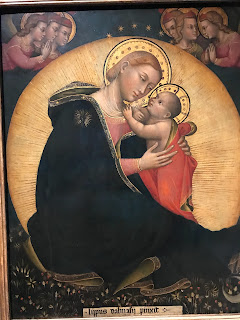We went to the Donatello Exhibition last week. I never knew the ninja mutant turtle to be so talented, nor we so lucky. We discovered a tunnel at South Kensington Tube Station that took us under busy streets and busier roads directly to the V&A. Up some steps and ‘Bob’s your uncle’ we were there. It was like discovering the North West Passage or the Harry Potter platform at Kings Cross.
To celebrate we had lunch in the V&A Café (not a ‘greasy spoon’ this) and took surreptitious photographs, though why surreptitious I have no idea. People were almost standing in line to snap its various nooks and motifs.
At last, our allotted time to enter the exhibition arrived and for me a name and two dates became suddenly real. Donatello 1386-1466. Until now he’d been only a name I could place in or around certain key events: The Hundred Years War, Agincourt-1415, The Battle of Nicopolis 1396, The War of the Roses, and of course, the Medici.
Donatello though, just a name until now.
Possibly that of the Lord Mayor of Florence, Niccolo da Uzzano, or Neri di Gino Capponi, merchant and politician. We shall never know, though personally I think it looks like the present day Lord Adonis. Uncanny resemblance. I love the way his expression changes as you look at him from different angles.
Earlier Reliquary busts created idealised images of a saint. Donatello’s San Rossore appears as a real person, a harbinger of the Renaissance to come.
Head of a bearded man, possibly a prophet. Art historians see his gaze as one experiencing a vision. I was caught by the attention to detail and how long I enjoyed studying it.
Not Donatello but Beltramino's God The Father. What’s truly striking, apart from the obvious is the painstaking craftsmanship. A copper sheet was hammered from the back to create the complexity of the front that was then gilded. The attention to detail in the contours of the face and beard is staggering. Great art, along with the myriad and unrecorded acts of kindness and generosity are flashes of light in an age of deprivation and brutality.
And I’d never heard of rilievo schiacciato before, still can’t pronounce it to the amusement of my wife. It literally means ‘squashed relief’. The technique, mastered by few, conjures up a sense of space and depth within just a few millimetres of carving.
Donatello’s use of ‘squashed relief’ conjuring up a sense of space and atmosphere within the shallowest depths of carving.
Ligolino was an earlier Sienese painter who undoubtedly influenced Donatello in his use of rocky terrains and inter-reacting figures. I love St Peter’s grumpy expression as he attacks one of the guards with what looks like a pencil.
Its name derives from The Virgin actually sitting on the ground with the Christ Child on her lap.
Not an imitator but one who likely influenced Donatello. Giovanni Pisano 1248 to 1319(?) here combines classicism with the Gothic. When viewed from the left, the Virgin’s hand points to the infant, who directs a blessing to the onlooker. It might be just me, but there’s an almost accusatory look in the Madonna’s expression.
Luca della Robbia was a younger rival and collaborator of Donatello. He used a new tin glazing technique which brought colour and protection to the terracotta surface. The heavenly blue and white figures imitate polished marble.
Worth contemplating the Madonna’s thoughtful gaze, perhaps signalling her meditation on Christ’s future sacrifice for humanity. The apple perhaps a reminder of the ‘fall’ about to be redeemed.
One of four bronze reliefs illustrating the miracles of St Anthony. Its story is simple, the execution complex: a starving mule given a choice between food and the Host, kneels in front of St Anthony to receive communion. The use of gilding guides the eye to the focal point of the Eucharist
Crucifixion
This is absolutely brilliant and bursting with contrasts – the texture of the draperies and armour, the flesh of the semi clad soldiers, the chiselling of the rocky landscape and roughly worked foliage. As the eye wanders, the reflective gilding draws the eye to the crucified Christ.
For those interested in technique, the textiles were hammer formed, Christ’s skin given a smooth sheen, and the feathers delicately modelled in the wax mould. The hair was chiselled in the cold metal after casting for added crispness.
Crucifix
It’s worth focusing on the deep eye sockets and tightly drawn flesh, the fluttering of the loin cloth suggesting Christ is still alive but in his final moments.
Bronze cherub designed to decorate the organ loft of Florence Cathedral. Art historians highlight its ‘fleshy rotund body’ which made me pause
Here Donatello exploits the bronze to create something almost alive. The open breeches suggests the Phrygian Shepherd Attis, and it has the wings of a young cupid (amorino) on its back. And then Donatello gets carried away, giving him the tail of a faun, the winged feet of Mercury, and a snake, most often associated with Hercules




























1 comment:
You taught me something today. I never knew about della Robbia's tin glazing technique. That was fascinating. Thank you.
Post a Comment